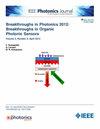基于集成光相控阵的自由空间光通信指向跟踪系统
IF 2.4
4区 工程技术
Q3 ENGINEERING, ELECTRICAL & ELECTRONIC
引用次数: 0
摘要
随着近地轨道卫星(LEOs)星座的激增,空对空激光通信具有高速、低延迟的特点,有可能实现飞机宽带互联网服务。飞机到低空激光链路的主要挑战是快速扫描、高带宽指向捕获跟踪(PAT)方法,以实现快速链路建立和切换以及补偿飞机平台振动引起的误差。本文介绍了一种基于集成光学相控阵(OPA)和四象限检测器(QD)的PAT系统。通过控制OPA的512个热移相器实现快速的方位扫描,而通过调节激光波长进行仰角扫描。采用量子点阵测量入射信标的到达角,并通过FPGA调整发射方向。实验表明,波束转向的方位角上升时间小于60 μs,仰角上升时间小于46 μs,指向精度为2.5 kHz。该系统具有复杂性低、体积小、无机械波束敏捷转向和高跟踪带宽能力等特点。本文章由计算机程序翻译,如有差异,请以英文原文为准。
Pointing Acquisition and Tracking System for Free Space Optical Communication Based on Integrated Optical Phased Array
With proliferation of low-earth-orbit satellite (LEOs) constellations, air-to-space laser communications have the potential to realize aircraft broadband Internet services due to its high speed and low latency. A major challenge in aircraft to LEOs laser link is the fast scanning, high-bandwidth pointing acquisition tracking (PAT) approach to achieve rapid link establishment and handover as well as to compensate for errors caused by vibrations of the aircraft platform. In this paper, a PAT system based on integrated optical phased array (OPA) and four quadrant detector (QD) is demonstrated. Rapid azimuth beam scanning is achieved by controlling the OPA’s 512 thermal phase shifters, while elevation scanning is carried out by adjusting the laser’s wavelength. The arrival angle of the incident beacon is measured by QD and used to adjust the emission direction through FPGA. The experiment shows that the beam steering rise time is less than 60 μs in azimuth and 46 μs in elevation, while the pointing accuracy is <0.05°>2.5 kHz. The PAT system has low complexity, small size, mechanical-free beam agility steering, and high tracking bandwidth capability.
求助全文
通过发布文献求助,成功后即可免费获取论文全文。
去求助
来源期刊

IEEE Photonics Journal
ENGINEERING, ELECTRICAL & ELECTRONIC-OPTICS
CiteScore
4.50
自引率
8.30%
发文量
489
审稿时长
1.4 months
期刊介绍:
Breakthroughs in the generation of light and in its control and utilization have given rise to the field of Photonics, a rapidly expanding area of science and technology with major technological and economic impact. Photonics integrates quantum electronics and optics to accelerate progress in the generation of novel photon sources and in their utilization in emerging applications at the micro and nano scales spanning from the far-infrared/THz to the x-ray region of the electromagnetic spectrum. IEEE Photonics Journal is an online-only journal dedicated to the rapid disclosure of top-quality peer-reviewed research at the forefront of all areas of photonics. Contributions addressing issues ranging from fundamental understanding to emerging technologies and applications are within the scope of the Journal. The Journal includes topics in: Photon sources from far infrared to X-rays, Photonics materials and engineered photonic structures, Integrated optics and optoelectronic, Ultrafast, attosecond, high field and short wavelength photonics, Biophotonics, including DNA photonics, Nanophotonics, Magnetophotonics, Fundamentals of light propagation and interaction; nonlinear effects, Optical data storage, Fiber optics and optical communications devices, systems, and technologies, Micro Opto Electro Mechanical Systems (MOEMS), Microwave photonics, Optical Sensors.
 求助内容:
求助内容: 应助结果提醒方式:
应助结果提醒方式:


